Reserves and Accounts: Types, Movement, and Dividend Payments
VerifiedAdded on 2023/06/04
|6
|1059
|407
Report
AI Summary
This report provides a comprehensive analysis of reserves and accounts within a financial context. It begins by defining reserves and their significance in financial statements, emphasizing their role in retaining earnings and supporting future investments. The report then categorizes and explains various types of reserves, including revenue reserves (general and specific), capital reserves, secret reserves, and other reserves, such as those related to foreign currency translation. It also delves into the creation and purpose of capital redemption reserves and their relationship to share buybacks and debt repayment. The report further examines dividend payments, highlighting their source from free or revenue reserves and their impact on shareholder confidence. Additionally, it explores the movement in reserves, analyzing how these movements reflect transfers and applications of funds within the company. The conclusion summarizes the importance of reserves and accounts for organizational expansion and financial stability, emphasizing the role of various reserve types. The report references several books and journal articles to support its findings.
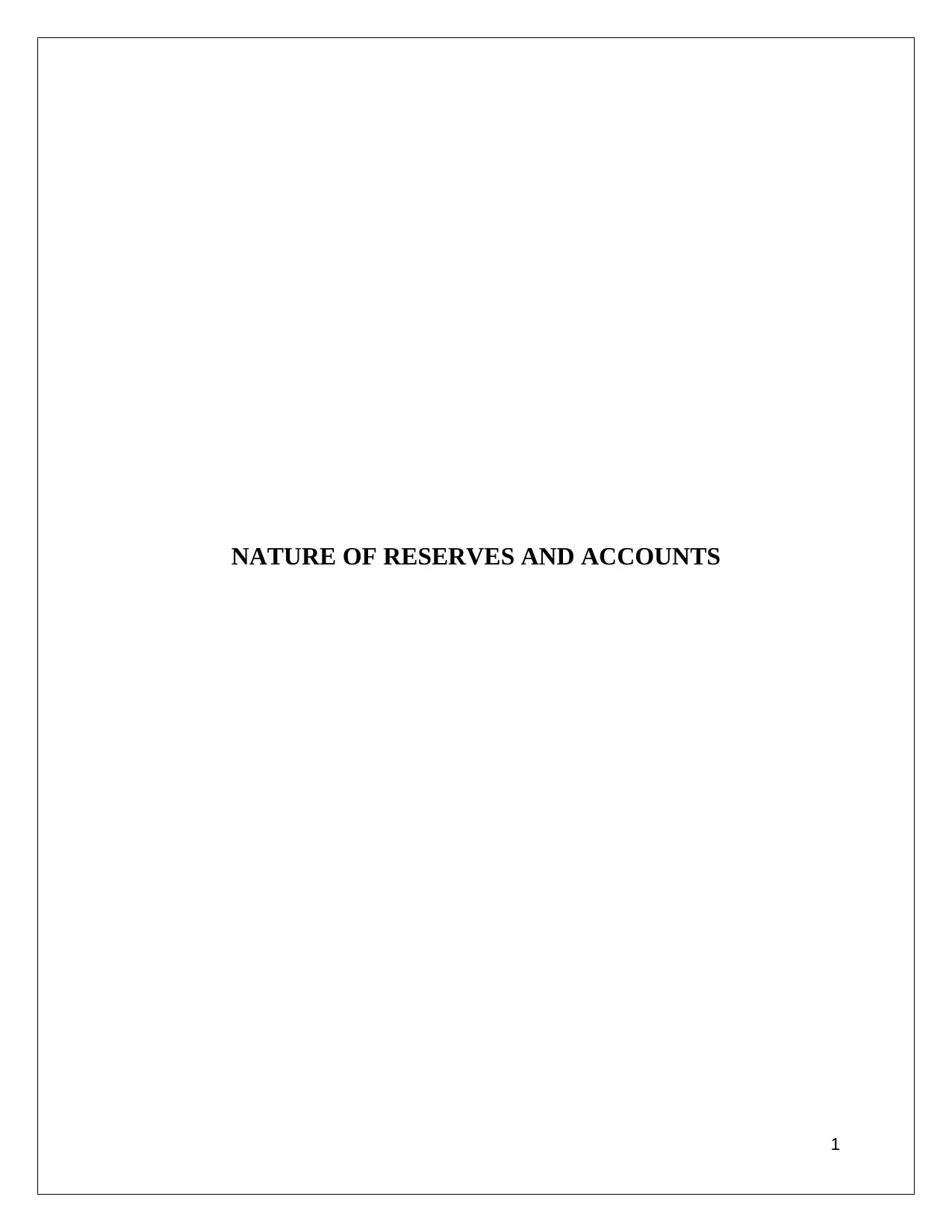
NATURE OF RESERVES AND ACCOUNTS
1
1
Paraphrase This Document
Need a fresh take? Get an instant paraphrase of this document with our AI Paraphraser

Table of Contents
Introduction......................................................................................................................................3
Nature of reserves and account........................................................................................................3
Revenue reserves..........................................................................................................................3
Capital reserves............................................................................................................................3
Secret reserves..............................................................................................................................3
Other reserves..............................................................................................................................4
Capital redemption reserves.........................................................................................................4
Dividend payment............................................................................................................................4
Movement in reserves......................................................................................................................4
Conclusion.......................................................................................................................................4
Reference list...................................................................................................................................6
2
Introduction......................................................................................................................................3
Nature of reserves and account........................................................................................................3
Revenue reserves..........................................................................................................................3
Capital reserves............................................................................................................................3
Secret reserves..............................................................................................................................3
Other reserves..............................................................................................................................4
Capital redemption reserves.........................................................................................................4
Dividend payment............................................................................................................................4
Movement in reserves......................................................................................................................4
Conclusion.......................................................................................................................................4
Reference list...................................................................................................................................6
2
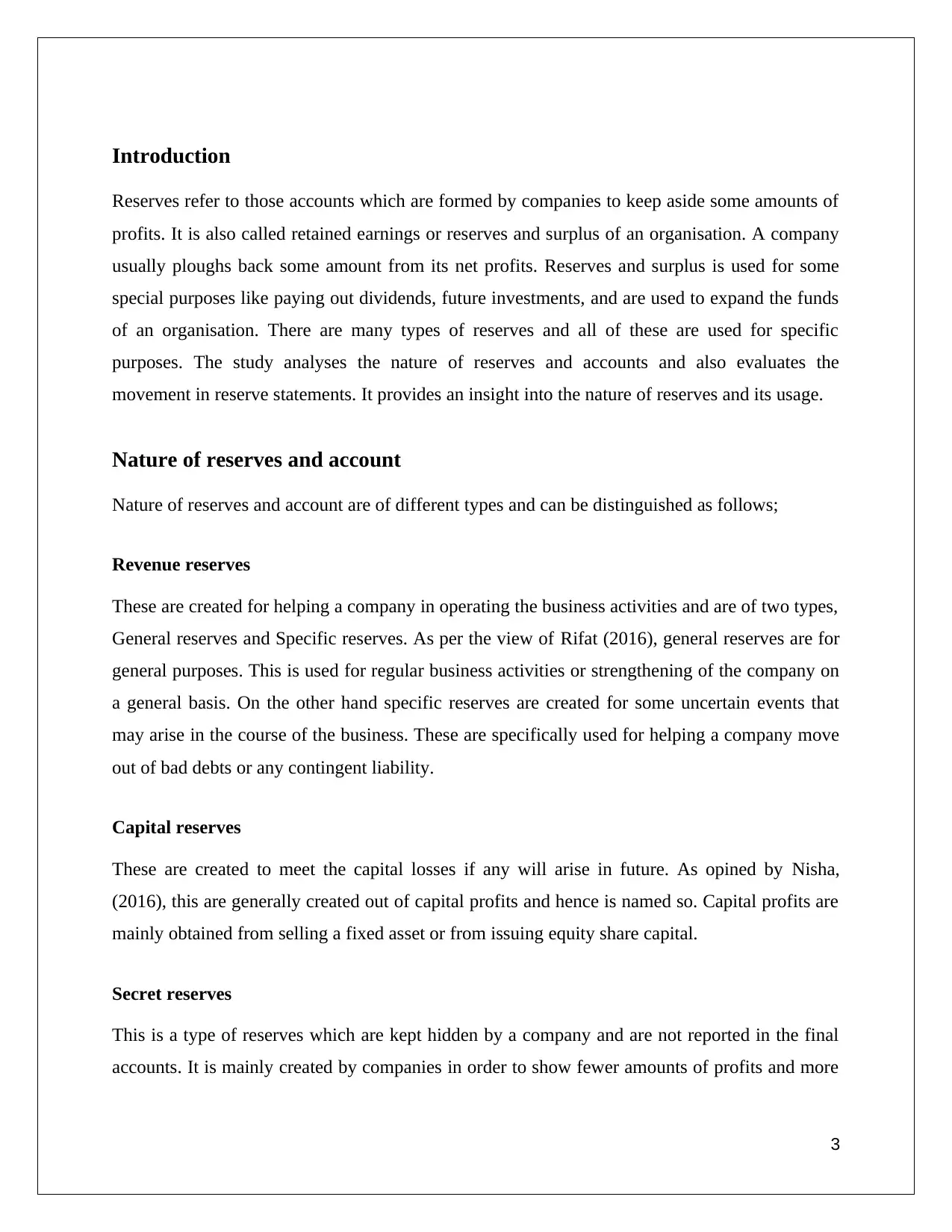
Introduction
Reserves refer to those accounts which are formed by companies to keep aside some amounts of
profits. It is also called retained earnings or reserves and surplus of an organisation. A company
usually ploughs back some amount from its net profits. Reserves and surplus is used for some
special purposes like paying out dividends, future investments, and are used to expand the funds
of an organisation. There are many types of reserves and all of these are used for specific
purposes. The study analyses the nature of reserves and accounts and also evaluates the
movement in reserve statements. It provides an insight into the nature of reserves and its usage.
Nature of reserves and account
Nature of reserves and account are of different types and can be distinguished as follows;
Revenue reserves
These are created for helping a company in operating the business activities and are of two types,
General reserves and Specific reserves. As per the view of Rifat (2016), general reserves are for
general purposes. This is used for regular business activities or strengthening of the company on
a general basis. On the other hand specific reserves are created for some uncertain events that
may arise in the course of the business. These are specifically used for helping a company move
out of bad debts or any contingent liability.
Capital reserves
These are created to meet the capital losses if any will arise in future. As opined by Nisha,
(2016), this are generally created out of capital profits and hence is named so. Capital profits are
mainly obtained from selling a fixed asset or from issuing equity share capital.
Secret reserves
This is a type of reserves which are kept hidden by a company and are not reported in the final
accounts. It is mainly created by companies in order to show fewer amounts of profits and more
3
Reserves refer to those accounts which are formed by companies to keep aside some amounts of
profits. It is also called retained earnings or reserves and surplus of an organisation. A company
usually ploughs back some amount from its net profits. Reserves and surplus is used for some
special purposes like paying out dividends, future investments, and are used to expand the funds
of an organisation. There are many types of reserves and all of these are used for specific
purposes. The study analyses the nature of reserves and accounts and also evaluates the
movement in reserve statements. It provides an insight into the nature of reserves and its usage.
Nature of reserves and account
Nature of reserves and account are of different types and can be distinguished as follows;
Revenue reserves
These are created for helping a company in operating the business activities and are of two types,
General reserves and Specific reserves. As per the view of Rifat (2016), general reserves are for
general purposes. This is used for regular business activities or strengthening of the company on
a general basis. On the other hand specific reserves are created for some uncertain events that
may arise in the course of the business. These are specifically used for helping a company move
out of bad debts or any contingent liability.
Capital reserves
These are created to meet the capital losses if any will arise in future. As opined by Nisha,
(2016), this are generally created out of capital profits and hence is named so. Capital profits are
mainly obtained from selling a fixed asset or from issuing equity share capital.
Secret reserves
This is a type of reserves which are kept hidden by a company and are not reported in the final
accounts. It is mainly created by companies in order to show fewer amounts of profits and more
3
⊘ This is a preview!⊘
Do you want full access?
Subscribe today to unlock all pages.

Trusted by 1+ million students worldwide
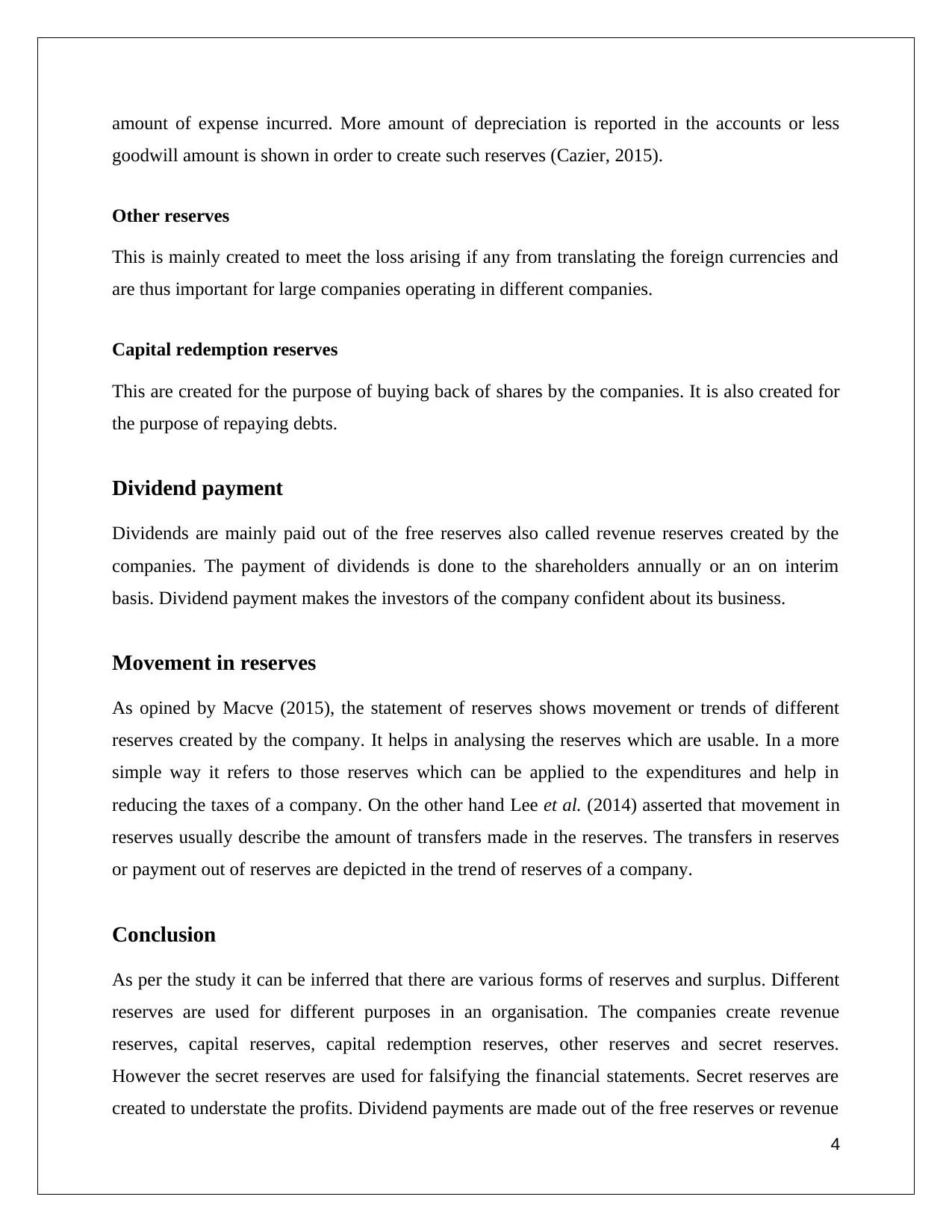
amount of expense incurred. More amount of depreciation is reported in the accounts or less
goodwill amount is shown in order to create such reserves (Cazier, 2015).
Other reserves
This is mainly created to meet the loss arising if any from translating the foreign currencies and
are thus important for large companies operating in different companies.
Capital redemption reserves
This are created for the purpose of buying back of shares by the companies. It is also created for
the purpose of repaying debts.
Dividend payment
Dividends are mainly paid out of the free reserves also called revenue reserves created by the
companies. The payment of dividends is done to the shareholders annually or an on interim
basis. Dividend payment makes the investors of the company confident about its business.
Movement in reserves
As opined by Macve (2015), the statement of reserves shows movement or trends of different
reserves created by the company. It helps in analysing the reserves which are usable. In a more
simple way it refers to those reserves which can be applied to the expenditures and help in
reducing the taxes of a company. On the other hand Lee et al. (2014) asserted that movement in
reserves usually describe the amount of transfers made in the reserves. The transfers in reserves
or payment out of reserves are depicted in the trend of reserves of a company.
Conclusion
As per the study it can be inferred that there are various forms of reserves and surplus. Different
reserves are used for different purposes in an organisation. The companies create revenue
reserves, capital reserves, capital redemption reserves, other reserves and secret reserves.
However the secret reserves are used for falsifying the financial statements. Secret reserves are
created to understate the profits. Dividend payments are made out of the free reserves or revenue
4
goodwill amount is shown in order to create such reserves (Cazier, 2015).
Other reserves
This is mainly created to meet the loss arising if any from translating the foreign currencies and
are thus important for large companies operating in different companies.
Capital redemption reserves
This are created for the purpose of buying back of shares by the companies. It is also created for
the purpose of repaying debts.
Dividend payment
Dividends are mainly paid out of the free reserves also called revenue reserves created by the
companies. The payment of dividends is done to the shareholders annually or an on interim
basis. Dividend payment makes the investors of the company confident about its business.
Movement in reserves
As opined by Macve (2015), the statement of reserves shows movement or trends of different
reserves created by the company. It helps in analysing the reserves which are usable. In a more
simple way it refers to those reserves which can be applied to the expenditures and help in
reducing the taxes of a company. On the other hand Lee et al. (2014) asserted that movement in
reserves usually describe the amount of transfers made in the reserves. The transfers in reserves
or payment out of reserves are depicted in the trend of reserves of a company.
Conclusion
As per the study it can be inferred that there are various forms of reserves and surplus. Different
reserves are used for different purposes in an organisation. The companies create revenue
reserves, capital reserves, capital redemption reserves, other reserves and secret reserves.
However the secret reserves are used for falsifying the financial statements. Secret reserves are
created to understate the profits. Dividend payments are made out of the free reserves or revenue
4
Paraphrase This Document
Need a fresh take? Get an instant paraphrase of this document with our AI Paraphraser
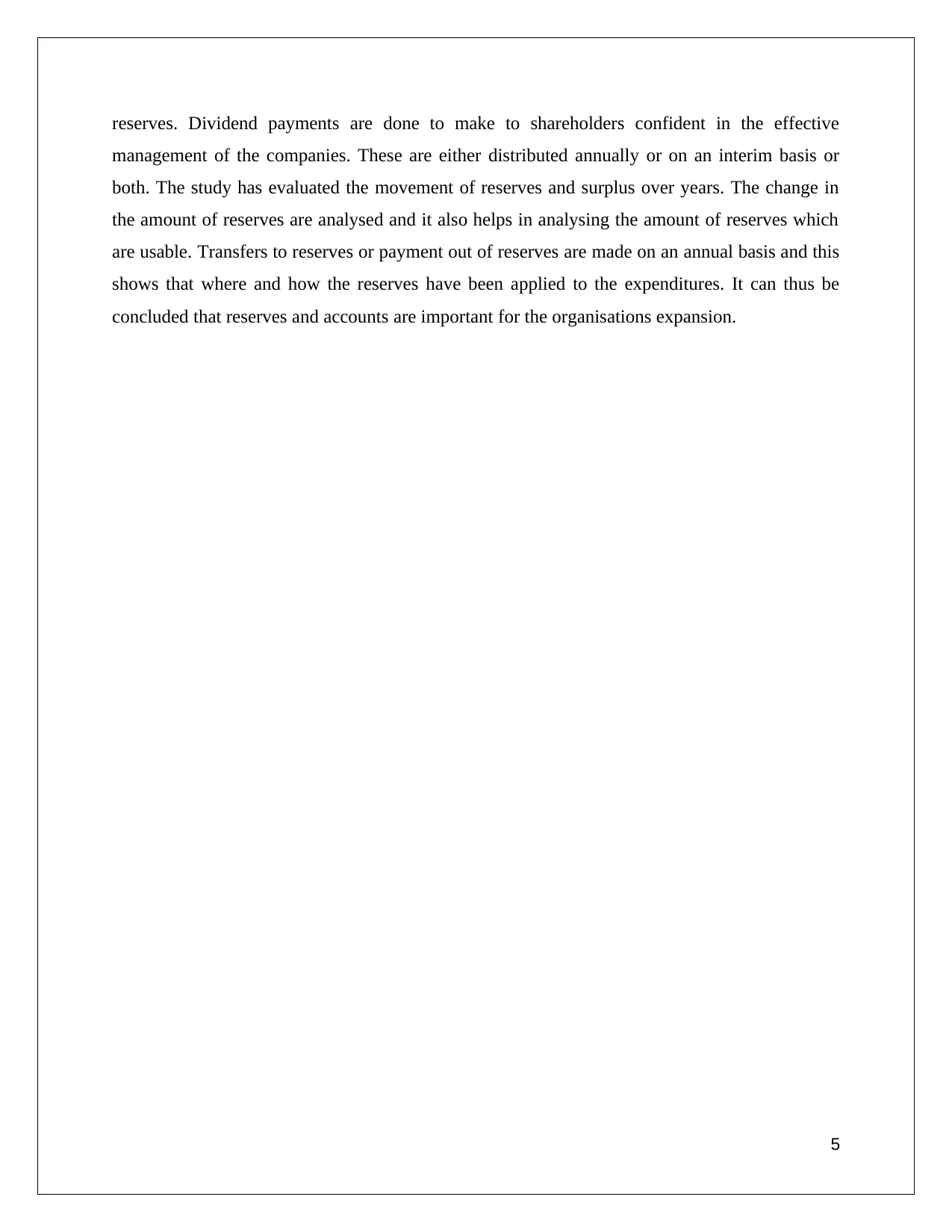
reserves. Dividend payments are done to make to shareholders confident in the effective
management of the companies. These are either distributed annually or on an interim basis or
both. The study has evaluated the movement of reserves and surplus over years. The change in
the amount of reserves are analysed and it also helps in analysing the amount of reserves which
are usable. Transfers to reserves or payment out of reserves are made on an annual basis and this
shows that where and how the reserves have been applied to the expenditures. It can thus be
concluded that reserves and accounts are important for the organisations expansion.
5
management of the companies. These are either distributed annually or on an interim basis or
both. The study has evaluated the movement of reserves and surplus over years. The change in
the amount of reserves are analysed and it also helps in analysing the amount of reserves which
are usable. Transfers to reserves or payment out of reserves are made on an annual basis and this
shows that where and how the reserves have been applied to the expenditures. It can thus be
concluded that reserves and accounts are important for the organisations expansion.
5
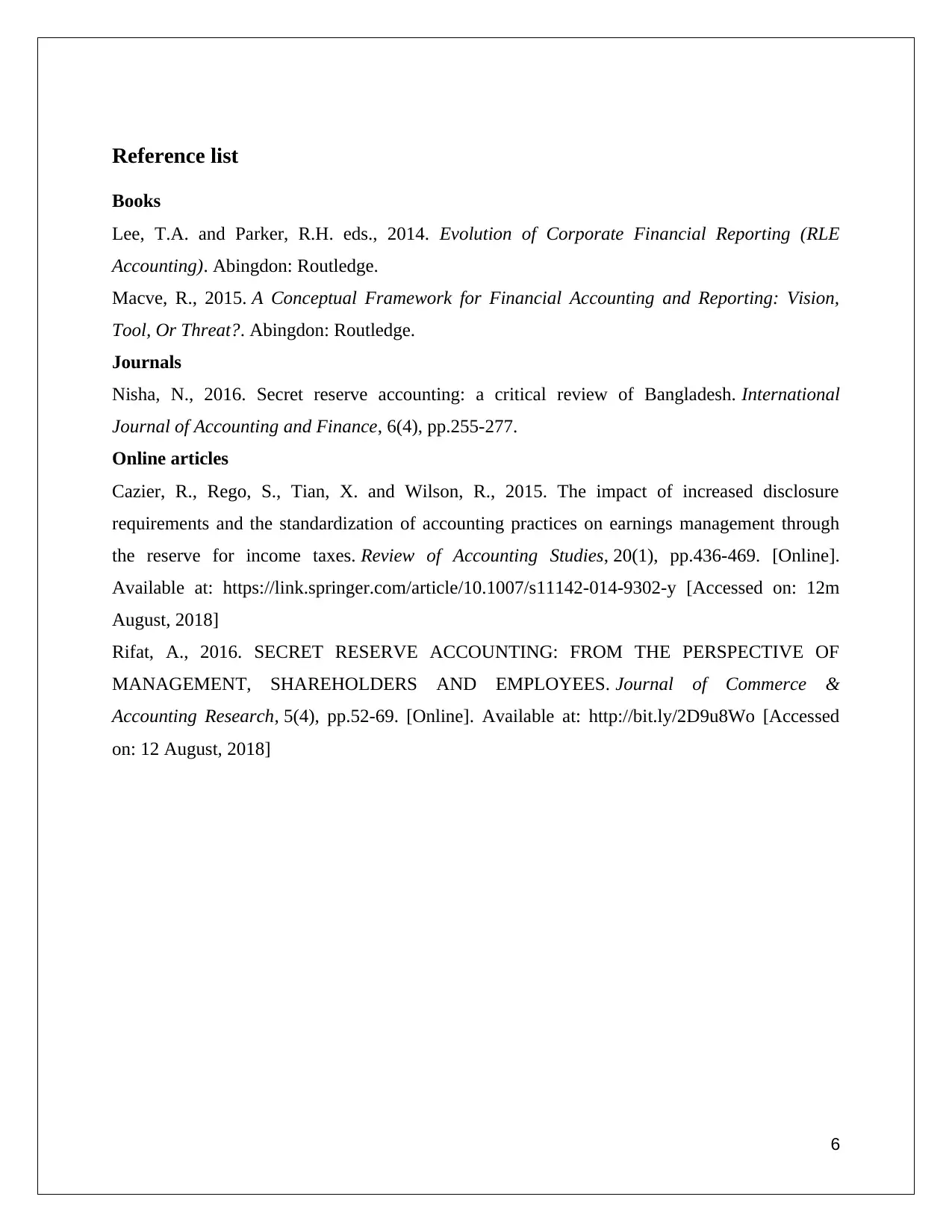
Reference list
Books
Lee, T.A. and Parker, R.H. eds., 2014. Evolution of Corporate Financial Reporting (RLE
Accounting). Abingdon: Routledge.
Macve, R., 2015. A Conceptual Framework for Financial Accounting and Reporting: Vision,
Tool, Or Threat?. Abingdon: Routledge.
Journals
Nisha, N., 2016. Secret reserve accounting: a critical review of Bangladesh. International
Journal of Accounting and Finance, 6(4), pp.255-277.
Online articles
Cazier, R., Rego, S., Tian, X. and Wilson, R., 2015. The impact of increased disclosure
requirements and the standardization of accounting practices on earnings management through
the reserve for income taxes. Review of Accounting Studies, 20(1), pp.436-469. [Online].
Available at: https://link.springer.com/article/10.1007/s11142-014-9302-y [Accessed on: 12m
August, 2018]
Rifat, A., 2016. SECRET RESERVE ACCOUNTING: FROM THE PERSPECTIVE OF
MANAGEMENT, SHAREHOLDERS AND EMPLOYEES. Journal of Commerce &
Accounting Research, 5(4), pp.52-69. [Online]. Available at: http://bit.ly/2D9u8Wo [Accessed
on: 12 August, 2018]
6
Books
Lee, T.A. and Parker, R.H. eds., 2014. Evolution of Corporate Financial Reporting (RLE
Accounting). Abingdon: Routledge.
Macve, R., 2015. A Conceptual Framework for Financial Accounting and Reporting: Vision,
Tool, Or Threat?. Abingdon: Routledge.
Journals
Nisha, N., 2016. Secret reserve accounting: a critical review of Bangladesh. International
Journal of Accounting and Finance, 6(4), pp.255-277.
Online articles
Cazier, R., Rego, S., Tian, X. and Wilson, R., 2015. The impact of increased disclosure
requirements and the standardization of accounting practices on earnings management through
the reserve for income taxes. Review of Accounting Studies, 20(1), pp.436-469. [Online].
Available at: https://link.springer.com/article/10.1007/s11142-014-9302-y [Accessed on: 12m
August, 2018]
Rifat, A., 2016. SECRET RESERVE ACCOUNTING: FROM THE PERSPECTIVE OF
MANAGEMENT, SHAREHOLDERS AND EMPLOYEES. Journal of Commerce &
Accounting Research, 5(4), pp.52-69. [Online]. Available at: http://bit.ly/2D9u8Wo [Accessed
on: 12 August, 2018]
6
⊘ This is a preview!⊘
Do you want full access?
Subscribe today to unlock all pages.

Trusted by 1+ million students worldwide
1 out of 6
Related Documents
Your All-in-One AI-Powered Toolkit for Academic Success.
+13062052269
info@desklib.com
Available 24*7 on WhatsApp / Email
![[object Object]](/_next/static/media/star-bottom.7253800d.svg)
Unlock your academic potential
Copyright © 2020–2025 A2Z Services. All Rights Reserved. Developed and managed by ZUCOL.





